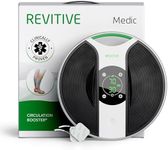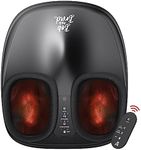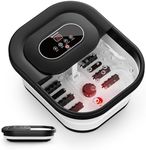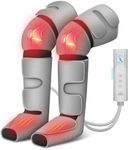Buying Guide for the Best Foot And Calf Massagers
Choosing the right foot-and-calf massager can greatly enhance your relaxation and recovery experience. These devices are designed to relieve tension, improve circulation, and provide comfort to your feet and calves. To find the best fit for you, it's important to understand the key specifications and how they align with your personal needs and preferences.Massage TechniquesMassage techniques refer to the different methods the massager uses to provide relief, such as kneading, rolling, shiatsu, and air compression. This spec is important because different techniques can target various muscle groups and provide different types of relief. If you prefer a deep tissue massage, look for a massager with kneading and shiatsu techniques. For a gentler experience, air compression might be more suitable. Consider what type of massage you enjoy or need for your specific condition.
Intensity LevelsIntensity levels indicate how strong or gentle the massage can be. This is crucial because it allows you to customize the massage to your comfort level. Massagers typically offer multiple intensity settings, ranging from low to high. If you have sensitive feet or calves, you might prefer a device with lower intensity options. Conversely, if you need a more vigorous massage to relieve deep muscle tension, higher intensity levels will be beneficial. Think about your pain tolerance and desired massage strength when choosing.
Heat FunctionThe heat function provides warmth during the massage, which can help to relax muscles further and improve blood circulation. This feature is important for those who experience chronic pain or stiffness. Some massagers offer adjustable heat settings, allowing you to control the temperature. If you often have cold feet or enjoy the soothing effect of heat, look for a massager with this feature. However, if you are sensitive to heat or have certain medical conditions, you might want to choose a model without it.
Size and PortabilitySize and portability refer to the dimensions and weight of the massager, as well as how easy it is to move and store. This is important for ensuring the massager fits comfortably in your living space and can be used conveniently. Larger, heavier models may offer more features but can be cumbersome to move. Smaller, lighter models are easier to transport and store but might have fewer functions. Consider where you will use the massager and whether you need to move it frequently.
Ease of UseEase of use encompasses the design and user interface of the massager, including how intuitive and accessible the controls are. This is important for ensuring you can operate the device without difficulty. Look for massagers with simple, clearly labeled buttons or remote controls. Some models also offer preset programs for added convenience. If you prefer a straightforward experience, choose a massager with a user-friendly design. If you enjoy customizing your massage, look for models with more advanced control options.
Material and Build QualityMaterial and build quality refer to the construction and durability of the massager. This is important for ensuring the device lasts and provides a comfortable experience. High-quality materials like soft, breathable fabrics and sturdy plastics can enhance comfort and longevity. If you plan to use the massager frequently, invest in a model with robust construction. For occasional use, a less expensive model with decent build quality might suffice. Consider how often you will use the massager and your preference for comfort and durability.
















